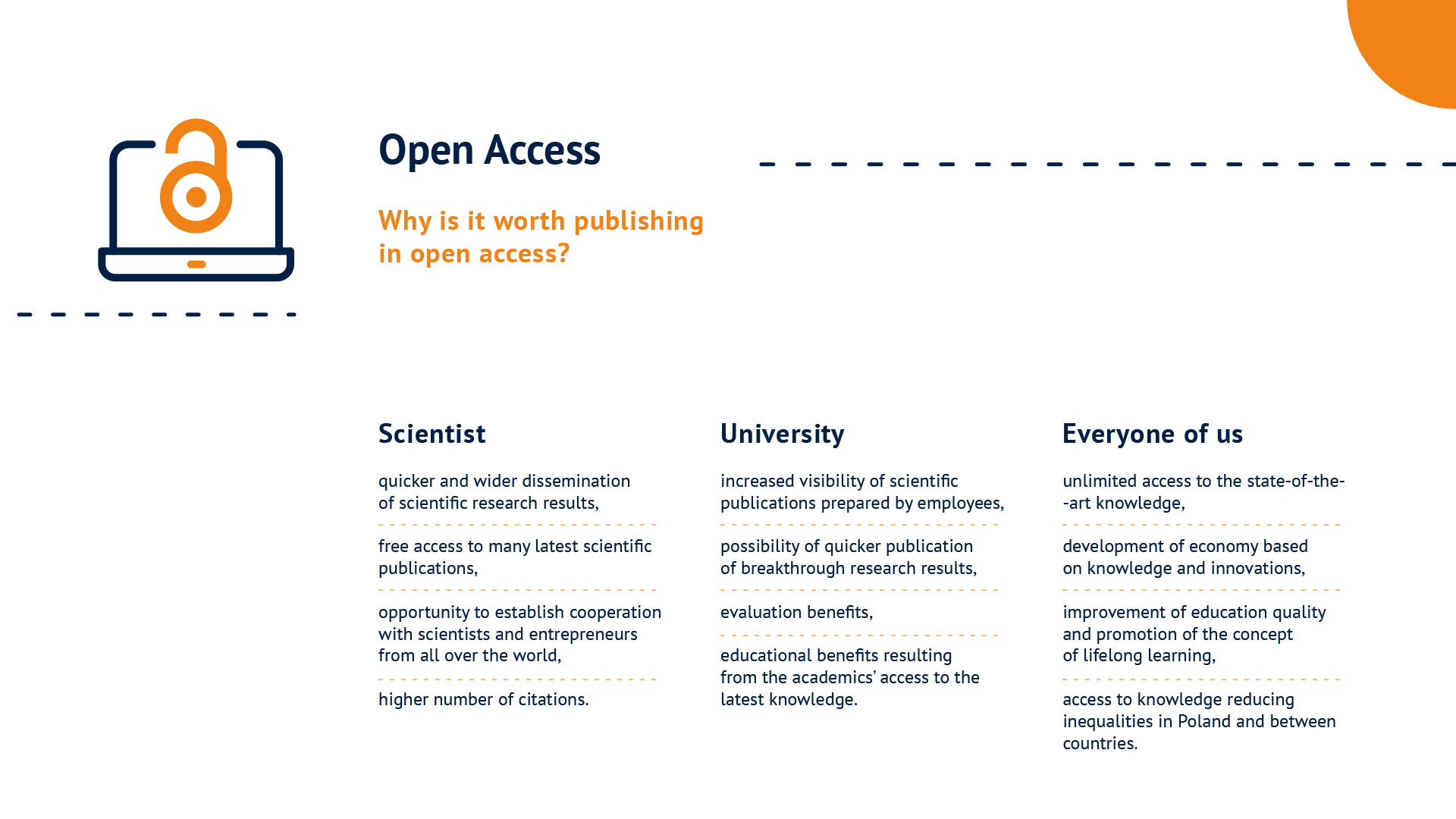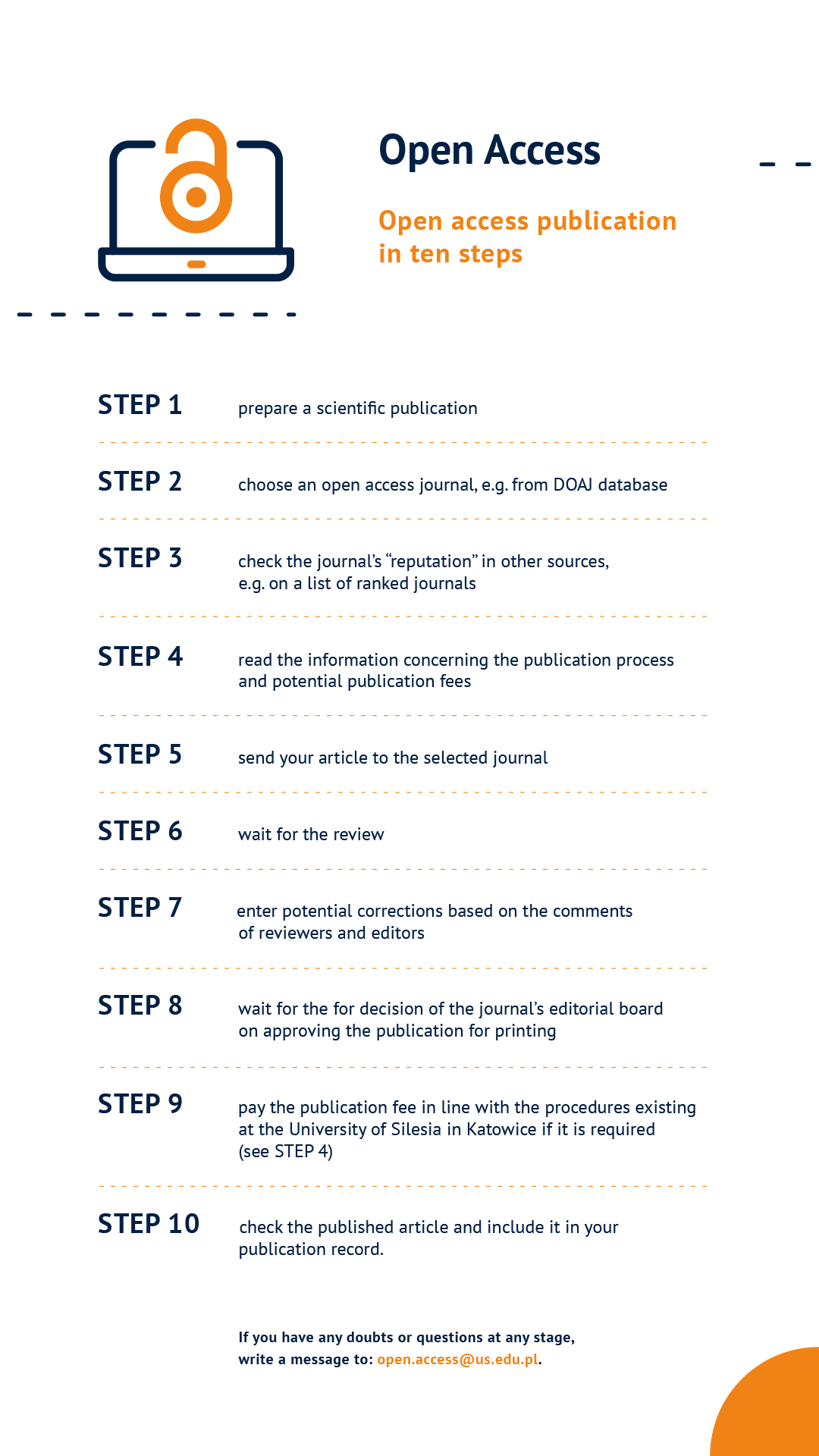How to publish in open access?
Open Access
open access publication
Open Access means universal access to reviewed scientific literature – without fees, logging in or other technical restrictions (including the requirement to install additional paid software).
Publishing in open access means that everyone may freely read, copy (in accordance with the right of quotation), print and use shared content for research and teaching purposes. All you need is to have an Internet connection.
Two ways to provide open access to scientific publications
Gold open access means publication of scientific and educational content in open access journals. Such journals do not charge fees to readers, however, some of them require the authors to pay a publication fee (APC – Article Processing Charges), which covers e.g. the editing costs.
Green open access means depositing a scientific article in an open repository. The authors publish their work in the repository themselves – taking into account the rules included in the agreement with the publisher. Not all publishing houses give their consent to storing a published article in the repository.
FAQ
Open access publication means free, unpaid, universal and immediate access to scientific and educational content. Such materials may be shared in journals as open access or in open repositories, which are used for management and long-term storage of digital documents.
The largest database of open access scientific journals is DOAJ – Directory of Open Access Journals (www.doaj.org). Currently (status as of February 2021), it includes approximately 16,000 journals in all disciplines. However, the list is not complete. Many open journals are not submitted for indexing in DOAJ, or they are rejected because they use predatory practices. Open journals can be either searched in databases (e.g. Web of Science or Scopus), or their status can be checked directly on websites. Journals most frequently publish information on the sharing mode (OA) either on their homepage, or directly on the article’s website. Open journals also have a defined license, i.e. the list of sharing terms and conditions (e.g. possibility of commercial use or creation of derivative works).
Certain open access journals are financed from other sources than with fees charged from the authors, so publication in such journals does not require any additional payments from the author. In DOAJ database (www.doaj.org), a majority (11,500 out of almost 16,000) of registered journals declare the lack of APC. The information on non-charging publication fees should be published on the journal website.
Certain open access journals charge APC (Article Processing Charges). In such case, the authors (or the institution they are associated with) shall bear the costs of publishing a scientific article.
The funds for publication fees can be obtained under projects (e.g. from the National Science Centre). Another method is to establish cooperation with a co-author who has secured funds for open access publications.
There is also a special programme of the Ministry of Science and Education to support the funding of open access scientific publications. The programme enables the authors affiliated in Polish institutions to publish open articles based on creative commons licenses in hybrid journals of selected publishers (e.g. Springer and Elsevier). The costs of publishing articles under the programme are covered with the with domestic license fee from the Ministry of Science and Education funds. The number of articles in the programme is limited, so not all submitted work (especially towards the end of the year) can be covered with these funds. Detailed information on the open publication programme is available at: www.ciniba.edu.pl.
Certain actions to support the publication of articles in open access have also been taken at the University of Silesia in Katowice as part of Research Excellence Initiative (e.g. Open Access call for proposals).
Publications in scientific (both open and hybrid) journals are prepared in the same way, so the sharing content method (open or closed) does not determine the speed of publication. This is influenced by the operational mode of the journal editorial board and publisher, number of articles, as well as whether the editorial board publishes articles on the online first basis, i.e. shares them online before the journal issue (volume) has been formally closed. It is worth noting that some publishers of open journals (e.g. MDPI and PloS) carry out the publication process very efficiently and quickly, however, this depends on the publication model and simplification of certain activities (e.g. putting the journal together, which may be time-consuming).
When it comes to publication itself, there are basically no differences. In both cases the work is available for all interested parties without paying fees or logging in. There are differences between the types of journals.
Open journals publish in open model all publications (the so-called gold open access) and do not charge subscription fees to the readers. The publishers gain income either from fees for articles paid by authors or affiliated units (APC – Article Processing Charges), or other funding sources.
On the other hand, hybrid journals are subscription-based. Access to articles is possible upon paying the subscription fee. However, the authors may choose gold access for their publication by paying APC. In such case, once the article is published, it will be available to all readers. In hybrid journals, only some articles are available in this way. The other articles, which are not available through gold open access, cannot be viewed or downloaded by the readers who have not subscribed this journal.
As a principle, there is no difference between preparing reviews in open and hybrid journals. However, certain publishing houses (e.g. MDPI) have based their publication model on a system of incentives for reviewers, thanks to which they get the reviews quickly, which significantly reduces the time needed to prepare an article.
When choosing a journal for publishing a scientific article, it is additionally worth checking its „reputation” in other knowledge sources. For this purpose, you can use the latest list of scored journals, databases (e.g. Scopus, Web of Science), or as a question to a librarian (zapytaj@ciniba.edu.pl).
Some open journals are the so-called predatory journals, i.e. they use unethical publication model which consists in simulating the review process and publishing all works that have been sent and paid for. Such publishers use the idea of open access only to draw income from the fees paid by the authors, so they are oriented towards publishing the highest possible number of papers, ignoring all editorial standards.
supervision: Dr Aneta Drabek | CINiBA







